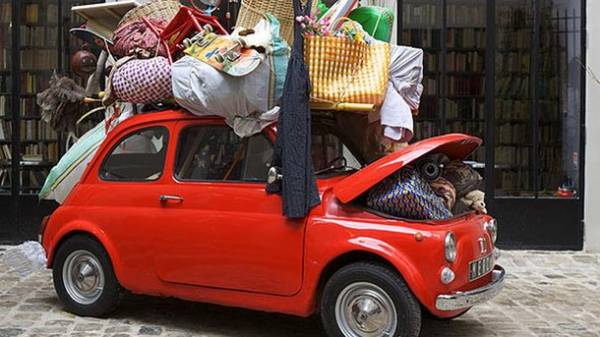
Many of car owners and passengers wonder about whether they were moving their own things? And it is not about bulky loads — although they are a bit late — but the simple and compact everyday things. But it is worth considering: even at the speed of 50 km/h when a sudden stop of the vehicle (e.g. in a collision) every little thing becomes harder for about 40 times! What does this mean in practice? And that casually tossed on the back seat of a two-liter of “mineral water” can fly in the back of the driver with a force of 80 kg! And this is not a harmless situation. Not to mention the fact that the history knows many cases when serious consequences have led an ordinary can of soda that fell on the car floor and rolled, for example, under the brake pedal. What to speak of the dangers fraught with loose spare in the trunk! How to protect yourself from troubles which can bring misplaced in the car? We will tell you.
INTERIOR: ALL FIXED
The modern car is equipped with many secluded and safe places for transportation of small items in the cabin. You only need to use them to ride safer. In an example, the already mentioned drinks. It is not necessary to carry a large plastic and especially glass containers. In the car, certainly there are Cup holders, which securely locks a plastic or paper Cup of coffee or tea, or a half-liter bottle of water. You need to take for a rule: in the car there should be no loose things! Indeed, in the event of a collision, — and this, alas, is not 100% insured, even the most experienced driver, everything is not fixed, it will randomly move around the cabin with the speed at which the vehicle was moving before the collision. Special danger represents all sorts of instrument. Imagine what injuries can cause a man a hammer flying through the cabin at a speed of 80 km/h? By the way, the most unsafe items left on the back shelf, because they are just about at head level. As for hard and large things to transport them in the cabin in General is undesirable: in the event of an accident they can pin down the person in the car. So, if you still need to take things you need, you should use the rear seat belts.
THE TRUNK: THE SECRETS OF COMPACTION
All that is not needed during a trip, it is better to carry there. Indeed, in the trunk cargo located in the vehicle separates at least the rear seat backrest and rear shelf, and sedans — and even a steel divider body. Besides the limited size of the Luggage compartment will not allow things to be dispersed and to a dangerous acceleration in the event of a collision.
But to place the goods to properly. You must do it as tightly as possible, placing the most heavy belongings downstairs. The trunks of many cars are equipped with extra partitions or nets which have a special attachment. Be sure to use all of these tools, carefully clipping them. Sharp edges and corners of the objects should be directed in the opposite from the interior side and to pass something soft. A heavy object should be placed so not to disturb the weight distribution of the car. Simply put, maximum at the center of the trunk, and in any case not near the lateral wall.
When transporting things in the boot, you need to consider not only their volume, but mass. In any case do not exceed the manufacturer’s recommended vehicle weight limit baggage allowance: this will not only reduce the resource of the rear suspension, but will significantly impair the car’s handling, obedience and the steering wheel will increase the braking distance.
Transporting a heavy load, it is necessary to securely fasten even uncommitted spare wheel at 50 km/h in the case a sudden stop hit in the back back with a force of about 500 kg — such a blow can not stand back, and certainly will not stand without consequences, the spine of the passenger. Now imagine what the force can reach 300 kg? But just as many, if not more, can be stowed in the Luggage compartment. Special care must be exercised to load the trunk of the car owners, in which the space of the cargo compartment goes outside of the wheelbase: there is the influence of over weight on handling the most powerful.
ON THE ROOF
Often even the most capacious trunk is not enough, and then the load is transported on the roof of the car. The market offers many solutions: all kinds of boxes, baskets, aeropoxy, special mounting accessories for the transport of certain goods (e.g., bicycles or snowboards).
First of all, recall that the carriage of goods outside the passenger compartment and trunk of the car are regulated by the Rules of the road. Transportation of baggage in the roof area is allowed if:
- does not create a danger to other road users;
- does not violate the stability of the vehicle and does not complicate the management of them;
- does not limit the review;
- not closing the lights, license plates and does not interfere with the correct reception of signals by other road users;
- does not create noise, dust, does not pollute the roadway and the environment.
If the load extends beyond the vehicle by more than 1 meter from the front or rear, or more than 40 inches on the sides, it needs to be marked with signal flags, and at night — reflectors or lamps.
To place cargo on the roof is so that the center of gravity is as low as possible. And carefully attached: in the optimal case there should be four points of support, at least three. To attach the cargo with ropes — and the more synthetic, nylon — impossible, because even the tight knots of the motion can be undone. Therefore, for mounting you need to use a special elastic “stretch” that you can buy in arts & crafts or DIY stores.
Remember that the maximum allowable mass of the cargo carried on the roof, is very limited. This figure is usually in the range of 70 kg (allowable weight of cargo in the instructions to the car). Exceeding this value can lead to deformation of the roof and pillars — but this is a very expensive auto body shops!







